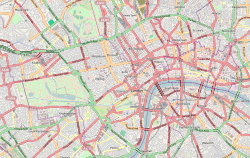|
Whitechapel Gallery
The Whitechapel Gallery is a public art gallery in Whitechapel on the north side of Whitechapel High Street, in the London Borough of Tower Hamlets. The original building, designed by Charles Harrison Townsend, opened in 1901 as one of the first publicly funded galleries for temporary exhibitions in London. The building is a notable example of the British Modern Style.[2] In 2009 the gallery approximately doubled in size by incorporating the adjacent former Passmore Edwards library building. It exhibits the work of contemporary artists and organizes retrospective exhibitions and other art shows.[3] HistoryThe gallery exhibited Pablo Picasso's Guernica in 1938 as part of a touring exhibition organised by Roland Penrose to protest against the Spanish Civil War.[4] The gallery played a major role in the history of post-war British art by promoting the work of emerging artists. Several significant exhibitions were held at the Whitechapel Gallery including This is Tomorrow in 1956, the first UK exhibition by Mark Rothko in 1961, and in 1964, The New Generation show which featured John Hoyland, Bridget Riley, David Hockney and Patrick Caulfield among others.[5][6][7][8][9] Initiated by members of the Independent Group, the exhibition brought Pop Art to the general public as well as introducing some of the artists, concepts, designers and photographers that would define the Swinging Sixties. Throughout its history, the gallery had a series of open exhibitions that provided a platform for the area's artist community, but by the early 1990s these open shows became less relevant as emerging artists moved to other areas. In the late 1970s, the critical importance of the Whitechapel Gallery was displaced by newer venues such as the Hayward Gallery, then in the 1980s it enjoyed a resurgence under the Directorship of Nicholas Serota. The gallery had a major refurbishment in 1986; and in 2009 expanded into the former Passmore Edwards Library building next door. The expansion, which doubled the gallery's physical size and nearly tripled its available exhibition space, now allows the Whitechapel Gallery to remain open to the public all year round.[5] Notable exhibitions 
PublicationsIn 2006, Whitechapel Gallery and MIT Press formed an editorial alliance to produce a new series of books entitled Documents of Contemporary Art.[16] Expansion The Whitechapel reopened in April 2009 after a two-year project, which approximately doubled the size of the Gallery by incorporating the adjacent former Passmore Edwards library building (vacated when Whitechapel Idea Store opened). The work cost approximately £13.5 million and was partly funded by the Heritage Lottery Fund. A full-size tapestry based on Pablo Picasso's Guernica, by Jacqueline de la Baume Dürrbach and loaned from the United Nations Art Collection, was included in the inaugural exhibition by Goshka Macuga.[17][18] and Isa Genzken.[19] As part of the expansion, a new Archive Gallery, a reading room and an archive repository (where the Whitechapel's historic records are held) have been created to support the Whitechapel's standing as an educational charity. The archives catalogue the very conception of the gallery, as well as the complete directors' files of correspondence which reveal the reasons behind key decisions in the Gallery's history.[20] Directors
References
External linksWikimedia Commons has media related to Whitechapel Gallery.
|
||||||||||||||||||

